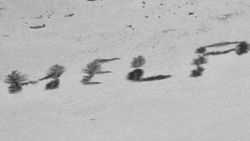If you were to greet a Neanderthal with a handshake, it might feel a little awkward.
The digits of the Stone Age people, who went extinct about 40,000 years ago, were much chunkier than ours. What’s more, a Neanderthal’s thumb would have stuck out from his hand at a much wider angle.
“If you were to shake a Neanderthal hand you would notice this difference,” said Ameline Bardo, a postdoctoral research fellow at the University of Kent’s School of Anthropology and Conservation in the United Kingdom.
“There would be confusion over where to place the thumb, and for a thumb fight I think you would win in terms of speed and movement!” she said via email.

The Neanderthals did use their hands differently from us, a new study published Thursday in the journal Scientific Reportshas suggested. Our archaic relatives, lead study author Bardo said, would have been more at ease with “squeeze grips” – the grip we use when we hold tools with handles like a hammer.
To find out how Neanderthals used their hands, Bardo and her colleagues had what they said was a unique approach.
Other studies have quantified how shapes in thumb bones vary in Neanderthals and modern humans, as well as other fossil human relatives. Most research to date, however, has onlylooked at the bones in isolation– until now.
Analysis of joint movement
The researchers used 3D mapping to analyze the joints between the bones responsible for movement of the thumb – referred to as “the trapeziometacarpal complex” – of the remains of five Neanderthal individuals. The scientists then compared the results to measurements taken from the remains of five early modern humans and 50 recent modern adults.
“Our study is novel in looking at how the variation in the shapes and orientations of the different bones and joints relate to each altogether,” she said.
“Movement and loading of the thumb is only possible by these bones, as well as the ligaments and muscles, working together so they need to be studied together,” she said.
While their meatier hands perhaps suggest a lack of dexterity, Neanderthals were definitely able to use a precision grip – like we would hold a pencil, Bardo said.
“The joint at the base of the thumb of the Neanderthal fossils is flatter with a smaller contact surface between the bones, which is better suited to an extended thumb positioned alongside the side of the hand,” she explained. “This thumb posture suggests the regular use of power ‘squeeze’ grips.”
By contrast, human thumbs have joint surfaces that are generally larger and more curved, “which is an advantage when gripping objects between the pads of the finger and thumb, a precision grip,” she said.

Neanderthals made specialized tools, painted caves, threaded seashells to wear as jewelry and made yarn – but they may have found precision grips “more challenging” than we do, Bardo said.
The powerful squeeze grip would have helped Neanderthals grasp spears while hunting and use stone scrapers or knives to work wood or animals skins. It might have been harder for Homo neanderthalensis, though, to use strong precision grips such as using flakes of stone between the pads of the finger and thumb to cut meat, Bardo said.
However, she noted that there is a big variation among modern humans when it comes to dexterity – and that could also have existed among Neanderthals.
Neanderthals walked the Earth for a period of about 350,000 years before they disappeared, living in what’s now Europe and parts of Asia. It’s thought they overlapped with modern humans geographically for a period of more than 30,000 years after humans migrated out of Africa.
“Their hand anatomy and the archaeological record makes abundantly clear that Neanderthals were very intelligent, sophisticated tool users and used many of the same tools that contemporary modern humans did,” Bardo said.























